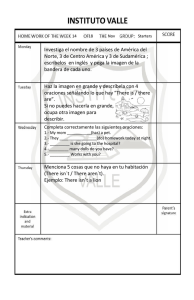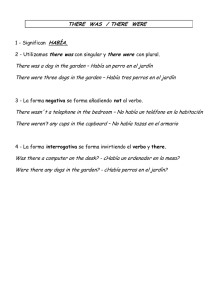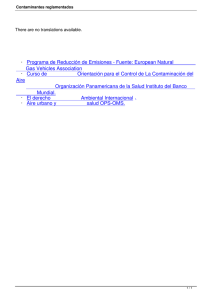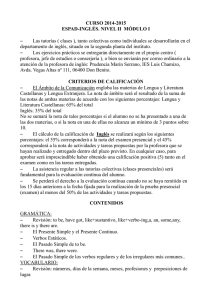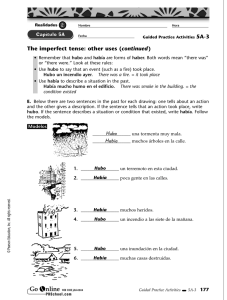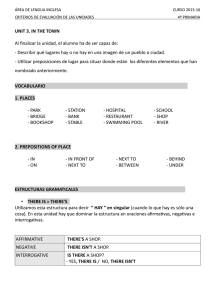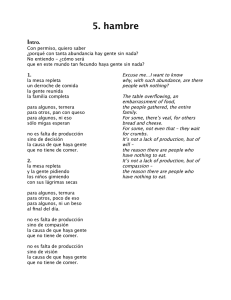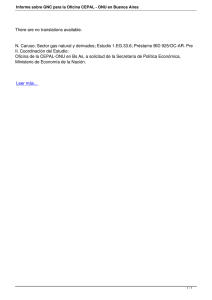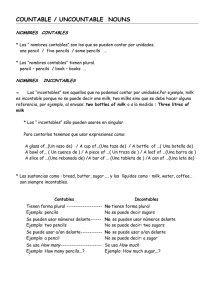THERE BE - Universidad América Latina
Anuncio
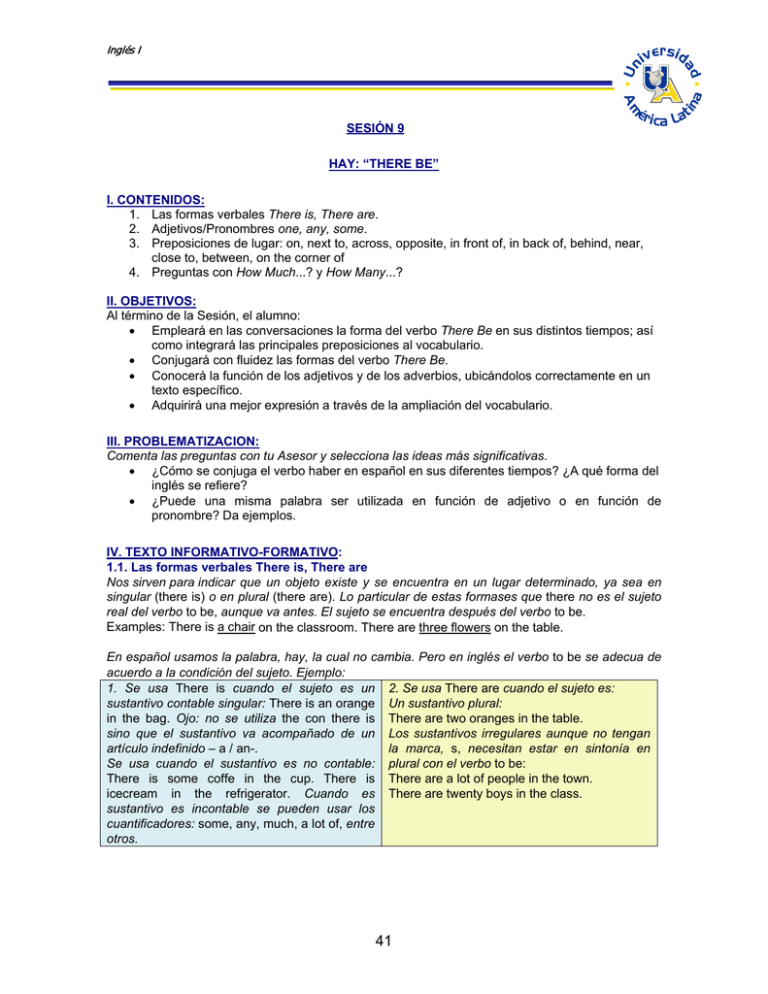
Inglés I SESIÓN 9 HAY: “THERE BE” I. CONTENIDOS: 1. Las formas verbales There is, There are. 2. Adjetivos/Pronombres one, any, some. 3. Preposiciones de lugar: on, next to, across, opposite, in front of, in back of, behind, near, close to, between, on the corner of 4. Preguntas con How Much...? y How Many...? II. OBJETIVOS: Al término de la Sesión, el alumno: • Empleará en las conversaciones la forma del verbo There Be en sus distintos tiempos; así como integrará las principales preposiciones al vocabulario. • Conjugará con fluidez las formas del verbo There Be. • Conocerá la función de los adjetivos y de los adverbios, ubicándolos correctamente en un texto específico. • Adquirirá una mejor expresión a través de la ampliación del vocabulario. III. PROBLEMATIZACION: Comenta las preguntas con tu Asesor y selecciona las ideas más significativas. • ¿Cómo se conjuga el verbo haber en español en sus diferentes tiempos? ¿A qué forma del inglés se refiere? • ¿Puede una misma palabra ser utilizada en función de adjetivo o en función de pronombre? Da ejemplos. IV. TEXTO INFORMATIVO-FORMATIVO: 1.1. Las formas verbales There is, There are Nos sirven para indicar que un objeto existe y se encuentra en un lugar determinado, ya sea en singular (there is) o en plural (there are). Lo particular de estas formases que there no es el sujeto real del verbo to be, aunque va antes. El sujeto se encuentra después del verbo to be. Examples: There is a chair on the classroom. There are three flowers on the table. En español usamos la palabra, hay, la cual no cambia. Pero en inglés el verbo to be se adecua de acuerdo a la condición del sujeto. Ejemplo: 1. Se usa There is cuando el sujeto es un 2. Se usa There are cuando el sujeto es: sustantivo contable singular: There is an orange Un sustantivo plural: in the bag. Ojo: no se utiliza the con there is There are two oranges in the table. sino que el sustantivo va acompañado de un Los sustantivos irregulares aunque no tengan artículo indefinido – a / an-. la marca, s, necesitan estar en sintonía en Se usa cuando el sustantivo es no contable: plural con el verbo to be: There is some coffe in the cup. There is There are a lot of people in the town. icecream in the refrigerator. Cuando es There are twenty boys in the class. sustantivo es incontable se pueden usar los cuantificadores: some, any, much, a lot of, entre otros. 41 Inglés I Así tenemos que la forma afirmativa se forma de la siguiente manera: Afirmative form. There is + a barber shop Hay una peluquería. There are + three supermakets Hay tres supermercados Las oraciones existenciales There is / There are construyen su forma negativa con la partícula not: Negative form There isn’t + any orange. No hay ninguna naranja There aren’t No hay + three supermakets tres supermercados Cuando se desea expresar que no hay ninguno o ninguna se usa el cuantificador any. La forma interrogativa se constituye invirtiendo el verbo to be y el sujeto aparente There. Question form. Is there + a baber shop? ¿Hay una peluquería? Are there + Ten boys in the house? ¿Hay diez muchachos en la casa? 2.1. Adjetivos/Pronombres one, any, some Son adjetivos y pronombres indefinidos, ya que no muestran un número exacto. Some y Any son los más importantes y significan algún, alguna, algunos, algunas. Any puede significar también ningún, ninguna, ningunos, ningunas. Some se aplica solo en afirmaciones y preguntas: I want some water/Do you want some water? Any se usa en expresiones negativas e interrogatives: I don’t want any orange juice. Don’t you want any orange juice? Can you lend me some money? ¿Me puedes prestar -algo de- dinero? Is there any milk in the fridge? ¿Hay –algo- de leche en la nevera? I'll need some sugar. Necesitaré -algo de- azúcar. Do you have any idea? ¿Tienes alguna idea? Some, any, every y la negación no al mezclarse permiten construir la mayoría de pronombres indefinidos. Se unen a las formas de: Body: cuerpo, hace referencia a personas: somebody, anybody, someone, nobody, everybody – alguien, nadie/ninguno, alguno/a, nadie, todos/as Thing: cosa, hace referencia a cualquier objeto: something, anything, nothing –algo, nada, nadaOne: uno, hace referencia a personas: no one/none –nadie, ninguno/aWhere: lugar donde, hace referencia a lugares: everywhere, nowhere –en todos los lugares, en ningún sitio- 42 Inglés I La mayoría de estas palabras llevan, dentro de la oración, un verbo en singular, excepto everybody que puede llevar verbo plural o singular: Is everybody fine? /Are everybody fine? . Ejemplos de los adjetivos/pronombres indefinidos. Is there a library near here? Habrá una biblioteca cerca de aquí? Yes, there is. There’s one on Pine Street Si ahí/allá está. Ahí/allá está una en la calle Pine. No, there isn’t. But there’s one next to the laundromat. No, ahí/allá no está. Pero ahí/allá está una al lado de la lavandería. Are there any travel agencies around here? – ¿Habrá por aquí algunas agencias de viajes? Yes, there are. There are some on First Avenue. Si, ahí/allá hay. Ahí/allá están algunas en la primera avenida. No, there aren´t. But there are some on second avenue – No, ahí/allá no hay. Pero ahí/allá hay algunas en la segunda avenida. 3.1. Preposiciones de lugar: on, next to, across, opposite, in front of, in back of, behind, near, close to, between, on the corner of Las preposiciones de lugar permiten informar sobre la ubicación de alguien o de algo. On: Se coloca delante de nombres de lugares con base como mesas, suelos y bases. Se usa con días de la semana, fechas y fiestas. Significa: Sobre, encima, tocando, el comienzo de algo y su continuidad: Ejemplos: It’s on the table - Está sobre la mesa. See you on Monday Te veré el lunes. Being on a diet - Seguir una dieta. Go on / Read on / Sigue - Sigue leyendo. Come on – Vamos. Switch it on - Encender algo y que continúe encendido. What’s on today? ¿Qué sucede hoy? On foot - A pie. On the violin - Nos ponemos al violin. Based on a true store Basado en una historia real. He was on the phone for over half an hour - Estuvo al teléfono por más de media hora - What is new on the news? - ¿Qué hay de nuevo en las noticias? Keep on driving on the right - Continua conduciendo por la derecha. Next to: Al igual que beside significa al lado de, junto a. Se pueden usar de manera indistinta, eso depende del contexto y del que habla. Ejemplos: The supermarket is next to –beside- the bank - El supermercado está junto al banco-. Sit next to –beside- me - Siéntate a mi lado. Across / from: Significa movimiento de un lugar a otro: motion verb + across + noun: The dog run across the yard. Puede significar al otro lado de un lugar: verb + across + noun: My brother lives across the street. Across from: Significa oposición o frente a: verb + across from + noun: My assistant's office is across from mine. My secretary sits across from me. Verb + across + noun + from + noun: My assistant's office is across the hall from mine. Opposite: Significa opuesto, delante de, en frente de, contrario. Cuando se habla de personas se traduce como delante y cara a cara. Ejemplos: The bank is opposite the market - El banco está en frente del mercado. She is sitting opposite me – Ella está sentada en frente de mí. In front of: Tiene relación con el anterior. La diferencia es que no implica estar delante y cara a cara. Ejemplos: The hotel is in front of the station - El hotel está en frente de la estación. He is standing in front of you - Está de pie frente a tí. In the back of: Significa atrás de, detrás de. Ejemplo. The student in the back of the classroom is lazy - El estudiante de atrás del salón o de la última fila es flojo. Behind: Significa atrás de, detrás de. Ejemplos: Behind her – detrás de ella. Behind the wall – detrás de la pared. Near: Significa cerca, cercano o próximo. Ejemplos: She's sitting near the pool – Ella está sentada cerca de la alberca. The golf ball is very near the cup – La bola de golf está muy cerca del hoyo. They're standing near the fountain – Ellos están de pie cerca de la fuente. This lake is near the mountains – Este lago esta cerca de las montañas. They're fishing near the lake – Ellos están pescando cerca del lago. 43 Inglés I Close to: Significa lo mismo que near –cerca-: Your house is close to the metro station – Tu casa está cerca de la estación del metro. They are sitting close to each other – Ellos están sentados uno cerca del otro. También hace relación alguien muy amistoso o a una amistad muy estrecha: She is very close to her older sister – Ella es muy cercana a su hermana mayor. Between: Significa separación de dos cosas: noun + between + noun. My neighbor and I built a fence between our backyards – Mi vecino y yo construimos una cerca en medio de nuestros traspatios. Significa relación entre dos lugares: Route 604 goes between Americas and Independencia – La ruta 604 circula entre Américas e Independencia. Indica también escoger: You can have only one dessert, so please decide between cake and ice cream – Solo puedes tomar un postre, así que por favor elige entre un pastel y una nieve. También significa posición entre dos cosas: The bank is between the restaurant and the post office – El banco está entre el restaurant y el correo. On the corner of: Esta preposición se refiere a la esquina de un lugar, es decir, el punto, área o line que se forma por la unión de dos líneas, superficies o vías. Significa en la esquina de. Ejemplo: The coffee house is on the corner of Main St and 1st Ave – La cafetería está en la esquina de la calle Main y la primera avenida. Examples: 1. The hospital is on Alcade avenue – El hospital está en la avenida Alcalde 2. Emily’s house is on Juarez avenue and Reforma street – La casa de Emily está en la avenida Juárez y la calle Reforma 3. The school is next to the gas station – La escuela está al lado de la gasolinería 4. My apartment building is next to your apartment building – Mí edificio de departamentos está al lado de tu edificio de departamentos 5. The book store is across from the travel agency – La librería está cruzando la agencia de viajes 6. The new Chivas stadium is across from concentro – El nuevo estadio de las Chivas es cruzando Concentro 7. The hotel is opposite the train station – El hotel esta opuesto a la estación de tren. 8. Our new building is opposite Aurrera arboledas – Nuestro nuevo edificio esta opuesto a Aurrera Arboledas 9. The bakery is in front of the old factory – La pastelería está enfrente de la vieja fábrica 10. The park and the high school are in front of the movie theater – El parque y la preparatoria están enfrente de el cine. 11. The circus is in the back of their house – El circo está atrás de su casa 12. His swimming pool is in the back of the garage – Su alberca está atrás de la cochera 13. The fire station is behind the police station and the post office – La estación de bomberos está detrás de la estación de policía 14. The theater is behind the supermarket and the mall – El teatro está detrás de el supermercado 15. The Oxford university is near Boston – La Universidad de oxford está cerca a Boston 16. The barber shop is near the park – La peluquería está cerca del parque 17. The police station is close to the baseball stadium – La estación de policía está cercana al estadio de beisbol 18. Elektra is close to Fabricas de Francia – Elektra esta cercana a Fábricas de Francia 19. The Aerobus terminal is between Aeromexico and Mexicana terminals – La terminal de Aerobus esta en medio de las terminales de Aeroméxico y Mexicana 20. The church is between the park and the train station – La iglesia está en medio de el parque y la estación de tren 44 Inglés I 21. The Cathedral of Guadalajara is on the corner of Hidalgo Avenue and Alcalde Ave. - La catedral de Guadalajara está en la esquina de la avenida Hidalgo y la calle Corona Plaza Ciudadela is on the corner of Patria Avenue end Moctezuma Avenue – Plaza Ciudadela esta en la esquina de avenida Patria y la avenida Moctezuma 4.1. Preguntas con How Much...? How Many...? Se utilizan para preguntar por cantidades de algo. Si se trata de sustantivos contables, se aplica How many. Si se trata de sustantivos incontables, se usa How much. Estas expresiones siempre van seguidas de un sustantivo; luego, el verbo y el resto de la oración. How many cars do you have? ¿Cuántos autos tienes? How much money do you have? ¿Cuánto dinero tienes? How much se utiliza también para preguntar precios. How much does this car cost? ¿Cuánto cuesta este auto? How much do the potatoes cost? ¿Cuánto cuestan las papas? También se usan en forma genérica para preguntar "cuánto hay". En este caso, van seguidas del sustantivo y luego, is / are there. How many cars are there? ¿Cuántos autos hay? How much money is there? ¿Cuánto dinero hay? A estas preguntas se responde usando There is / are, dependiendo de si se trata de singular o plural, como ya hemos visto en lecciones anteriores. There are nine cars. Hay nueve autos. There is one dollar. Hay un dólar. Para hacer referencia a los sustantivos incontables, se pueden utilizar los envases o las medidas de los envases que los contienen, los cuales sí son contables... How much milk is there? ¿Cuánta leche hay? There are three liters. Hay tres litros. There are three bottles. Hay tres botellas. 45
